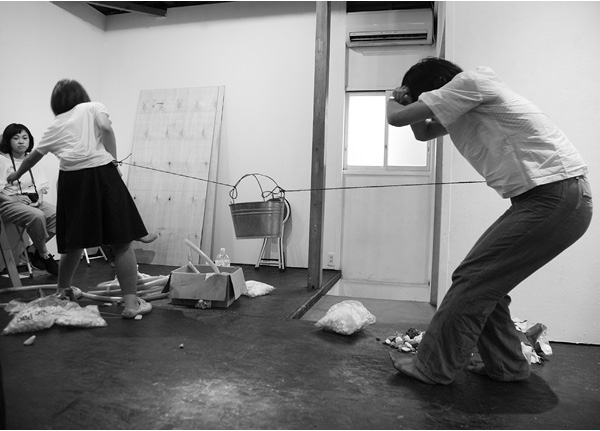
WORKSHOP
first performed on September 19, 2015
Art Center Ongoing, Tokyo, Japan
performed four times in 2015
MIRUKUSOUKO / MEGUMI KAMIMURA, AZUMI KAJIWARA, NAOTAKA MIYAZAKI
Tokyo, Japan
686225714i686225714n686225714f686225714o686225714@686225714k686225714a686225714m686225714i686225714m686225714u686225714r686225714a686225714m686225714e686225714g686225714u686225714m686225714i686225714.686225714i686225714n686225714f686225714o686225714 686225714/686225714 686225714m686225714i686225714r686225714u686225714k686225714u686225714s686225714o686225714u686225714k686225714o686225714@686225714g686225714m686225714a686225714i686225714l686225714.686225714c686225714o686225714m
kamimuramegumi.info/e_index.html
milksouko.com
WORKSHOP
MIRUKUSOUKO / MEGUMI KAMIMURA, AZUMI KAJIWARA, NAOTAKA MIYAZAKI
It is a performance piece named “Workshop” but at the same time the whole process is a workshop on making up the situation of a performance.
The audience gathers to see a performance, but they are first asked to join a workshop on how to become an audience. In other words, they are asked to both literally and figuratively play the role of an audience. Most parts are done non-verbally except the minimum instructions given by the facilitator.
In this piece, we defined “audience” as those who: watch the performance, follow spoken or unspoken rules without interrupting the performance, and keep active both sensuously and physically. The performer gives a performance, and draws attention from the audience. The role of the facilitator is to help the audience concentrate and observe the whole incident including their own bodies.
The actual performance can be described as follows:
The whole floor is covered with wooden boards. There are many objects such as stones, balls, hoses, plastic, or glasses under and around the boards, so as people walk on them, they make various noises, and become unstable. The performer repeats simple exercise-like movements on different spots, but she is tied with the workshop facilitator by a rope with a bucket hung in the middle, so the movements are often restricted. The performer and the facilitator are treated as a part of the whole stage set.
We announce to the audience that the workshop begins with how to become an audience. They are asked to clean up the floor and put stones in the hanging bucket. There is no chair and the performer moves around, so they have to stay standing and walk around so as not to crash into objects or other people. As the performance goes on, the facilitator starts to put or lean objects on various parts of the audience’s bodies, corresponding with the performer’s movements. By doing so, she makes them pay more attention to their own bodies as well as the process of balancing. Accordingly, they are guided to watch the performer’s movements, linking their physicality to hers.
In the end of the performance, the audience is again asked to lay the wooden boards back on the floor and the facilitator lays down under one of the boards. The performer keeps rolling on the unstable boards, and she finally stops when the rope is stretched to the limit.